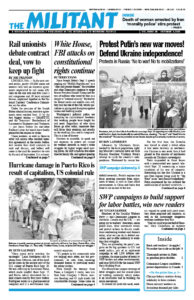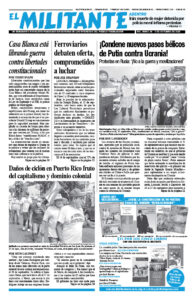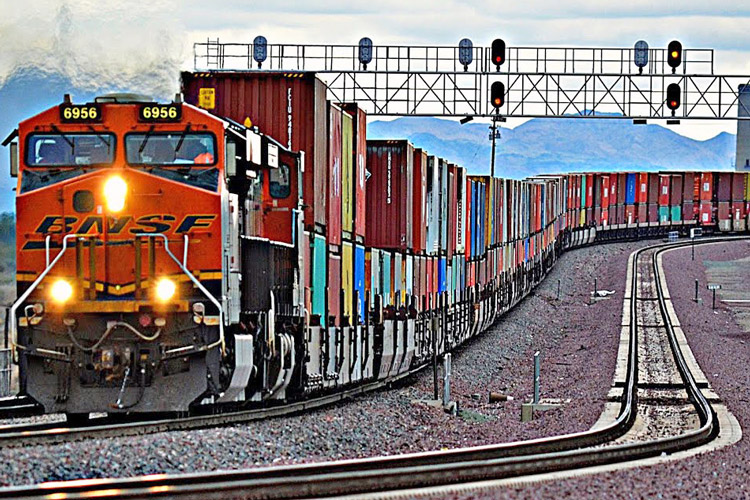LINCOLN, Neb. — In the next several weeks, nearly 100,000 union rail workers will vote on tentative agreements negotiated by rail union officials on the one side and five Class 1 rail companies and 30 local railroad bosses, organized together as the National Carriers’ Conference Committee, on the other.
Under the pressure of the Joseph Biden administration, tentative agreements were reached Sept. 15 by the two biggest unions — SMART-TD and the Teamsters’ Brotherhood of Locomotive Engineers and Trainmen — just hours before the anti-labor Railway Labor Act would have finally permitted the unions to strike.
These workers, as well as those in other rail unions who reached tentative agreements in the weeks before, will receive their draft contracts to read and discuss, and ballots will come in the mail for members to vote by the end of September. It is estimated the count will take 30 days or longer, possibly without a decision being announced before the Nov. 8 midterm elections.
On Sept. 14, nearly 75% of the 6,600 members of the International Association of Machinists, which organizes locomotive machinists, track equipment mechanics and facility maintenance workers, voted to reject their agreement. The IAM approved a strike if a better contract isn’t ratified by Sept. 29.
Two of the 12 unions — the Transportation Communications Union/IAM and the Brotherhood of Railway Carmen, representing over 11,000 clerical and rail car mechanical inspectors — ratified an agreement.
The Railway Labor Act, adopted in 1926, forces rail workers to go through an extended period of negotiations and “cooling off” periods that can take years before they can strike, or before the bosses can lock them out. This time negotiations began over two years ago in January 2020.
White House steps up pressure
As the clock toward a strike deadline counted down, the government’s National Mediation Board — formed to “regulate” relations between the rail unions and the bosses — ordered the unions that didn’t have a tentative agreement back to Washington Sept. 7. Within a few days 10 craft unions had reached tentative agreements.
One of the unions that did was the Brotherhood of Maintenance of Way Employees. “I do not think the tentative agreement addresses the ‘away from home’ expenses that my union’s members need,” Jake Forsgren, a track worker and welder in Nebraska and local chair of BMWE Lodge 1320, told the Militant Sept. 18. This key demand for the track workers has to do with the fact that they can be arbitrarily sent up to 1,000 miles away from home on an assignment and have to bear most of the expenses themselves before being paid back later. “I have every reason to believe the majority of the membership will vote against the agreement the way it reads now.”
Forsgren said workers should know the vote results by Oct. 10.
The two unions that held out until the last minute were SMART-TD and the Brotherhood of Locomotive Engineers and Trainmen. The sticking points for these workers, who actually run the trains, were moves by the rail bosses to make their work conditions worse, including harsh attendance policies backed up by the threat of termination for marking off sick, as well as the carriers’ demands for one-person “crews” operating the trains. Also at issue were work schedules that force workers to be on call 24/7.
The dangers these conditions create for rail workers, as well as those who live by the tracks, has been driven home by the death of three Union Pacific workers on the job this month.
Thousands of rail workers have quit over the last couple years, and the bosses haven’t been able to hire replacements. This makes conditions even worse.
The bosses’ position, backed by the government regulators, has been that these issues shouldn’t be part of the negotiations. The workers have insisted they should.
As the Sept. 16 strike deadline drew closer, the pro-boss media focused hourly on how the rail companies had agreed to accept the “generous” wage offer the Biden-appointed Presidential Emergency Board (another part of the red tape that wraps up rail workers and their unions) recommended. They also wailed about the enormous damage to the economy a strike would cause, as bosses across the country rely on the rail union members that operate the 7,000 cross-country freight trains daily. They said a strike would cost the employers more than $2 billion a day.
To ratchet up the pressure for an agreement, Biden called in to the negotiations that Labor Secretary Martin Walsh was holding with the unions and bosses Sept. 14, hours before the deadline to strike. Averting a walkout was vital for the Biden administration, facing the prospect of shipping disruptions and a new wave of potential price spikes in the run-up to midterm elections in November.
Biden boasts he is the most pro-union president in history.
House of Representatives Speaker Nancy Pelosi made it clear she was prepared to order Congress to shut down any strike that was called. She said that it has “in the past enacted legislation for such purposes” and “it is in the national interest that essential transportation services be maintained.”
She was referring to how Congress ordered rail unionists back to work in the last national rail strike in 1991 and in a 1992 lockout by the rail bosses.
The fight isn’t over
The boss press acts like the whole issue is settled, contracts signed and things can “get back to normal.” But most workers haven’t voted yet, many haven’t even seen the proposed pacts.
No one knows at this stage if other rail union members will join the Machinists and vote down their agreements. Many workers on the job express anger and frustration over the brutal working conditions and ongoing harassment from the bosses.
Regardless of how the contract votes turn out, the fight of rail workers against the attacks of the bosses will continue. And the efforts by rail workers to put up a fight is one of the reasons a Sept. 2 Gallup poll reported 68% approve of labor unions, the highest the pollster has registered in 57 years.


